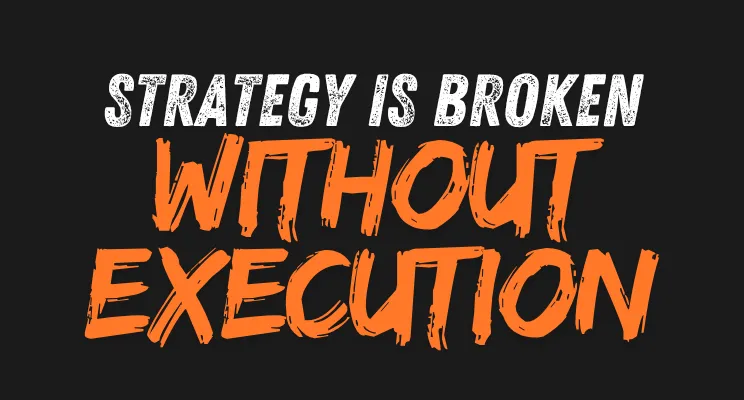
Business Strategy Is Broken Without Execution: How Leaders Can Fix It
A well-polished business strategy might look impressive on the boardroom screen. The goals are laid out. KPIs are tracked. Teams nod in agreement. On paper, it feels like the company is heading in the right direction.
Despite that, months later, leaders begin to wonder: Why hasn’t the needle moved?
Plans stall. Execution falters. Departments start drifting in different directions. People do the work, but progress feels disconnected from the larger goals. These breakdowns don’t happen because the strategy is weak. They happen because execution was never treated as a discipline of its own.
Many businesses assume that once a strategy is approved, execution is the natural next step. In practice, execution is a completely separate muscle, and most organisations never build it properly.
Why Execution Doesn’t Happen Automatically
Strategic planning often takes priority because it’s more comfortable. Leaders get to think big, run scenarios, and design visionary goals. Execution, however, is less glamorous. It involves details, accountability, and immediate feedback. This is where many leadership teams lose traction.
The belief that a clear strategy leads to natural implementation is one of the most dangerous assumptions in leadership. People don’t execute based on what’s written in a document they execute based on what they understand, what they believe in, and what they can influence.
Research published by MIT Sloan in 2024 revealed that 82% of middle managers could articulate their company’s strategy, yet only 29% felt confident implementing it in their day-to-day roles. This disconnect doesn’t stem from a lack of effort. It emerges from a lack of clarity, feedback, and infrastructure.
Execution fails when teams don’t know what to prioritise, don’t feel ownership over outcomes, and lack visibility into progress. When these gaps persist, strategy becomes a corporate ritual rather than a lived reality.
Common Pitfalls Leaders Overlook
Breakdowns in execution rarely happen during formal planning sessions. They occur in the smaller, day-to-day touchpoints handoffs between departments, skipped feedback loops, or silence around misalignment.
In one coaching engagement with a logistics company, leadership was convinced their three-year strategy was well understood. The goals were ambitious and well-framed. However, nine months in, every key milestone was delayed. A closer look revealed that each department had interpreted the goals differently. Execution had fractured not due to resistance, but because expectations were never translated into team-specific realities.
Miscommunication isn’t always loud. Sometimes it shows up as well-meaning teams pulling in slightly different directions. Over time, those degrees of misalignment compound. What starts as a minor drift eventually becomes strategic failure.
In situations like these, ownership is the missing piece. The strategy remains a leadership artefact rather than a team-led mission. Without ownership, strategy becomes a presentation. With it, strategy becomes execution.
What Execution-Driven Cultures Do Differently
High-performing organisations do not separate strategy from daily behaviour. Execution is not treated as a secondary phase. It is designed into how the organisation operates, communicates, and holds itself accountable.
First, these companies build feedback systems that surface execution gaps in real time. Meetings are not just update sessions they’re designed to identify roadblocks, prioritise next actions, and adjust plans based on current realities. Strategic alignment is revisited regularly, not just at quarterly reviews.
Second, they embed clarity into every role. Each team member understands how their work contributes to broader goals. Roles are not confined to tasks; they are linked to purpose. This reduces guesswork and accelerates decision-making.
Third, execution is shared, not hoarded. Leaders distribute decision-making authority. Teams have autonomy within guardrails. Progress is measured, discussed, and refined as a group effort not an executive directive.
Finally, these organisations make space for tension. Execution creates pressure. It brings up discomfort. Rather than ignoring it, effective leaders use that tension to improve how they operate. They teach their teams how to move through complexity, rather than freeze in it.
The Case for Strategy Built on Trust
Execution is not just a technical skill it’s an emotional contract. People will go further for a strategy they believe in, especially when they feel part of shaping it. This is where many leadership teams lose momentum. They build strategy in isolation, then ask their teams to adopt it wholesale.
A retail company I once worked with had bold expansion plans and a leadership team fully invested in the vision. Despite this, middle management stalled. The issue wasn’t resistance it was exclusion. Managers had not been included in the early planning stages. When it came time to implement, they lacked the context and confidence to move quickly.
Once those teams were brought into the strategic conversation and empowered to localise the plan, execution improved across every metric. The strategy didn’t change. The sense of ownership did.
This isn’t a special case. It’s a reminder that execution isn’t just about aligning metrics. It’s about aligning people and that requires trust.
Your Strategy Only Works If It Lives Outside the Boardroom
Too many businesses confuse momentum with clarity. They celebrate task completion, not whether the right tasks were chosen. They monitor project volume without checking if the work contributes meaningfully to their outcomes.
If execution isn’t built into your leadership rhythm, you won’t catch misalignment until it’s too late. You’ll keep presenting plans. Your team will keep nodding. And the gap between intention and action will continue to grow.
Execution isn’t a phase to follow strategy. It’s the heartbeat that brings strategy to life.
To close the gap between strategy and success, leaders must move beyond planning. They must create space for active execution measured by clarity, ownership, and progress. A great strategy is only as strong as the team that breathes life into it.
